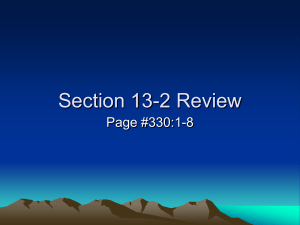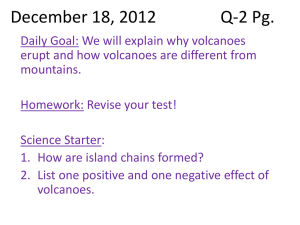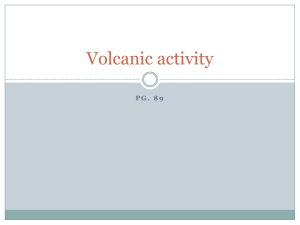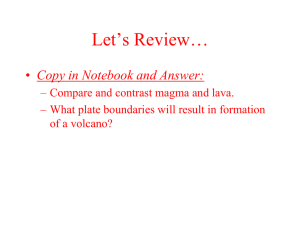Volcano Deformation Module
advertisement
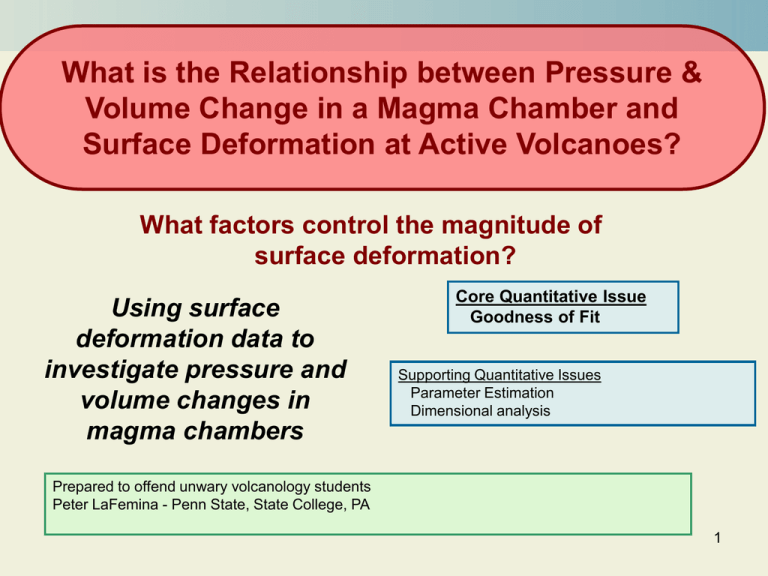
What is the Relationship between Pressure & Volume Change in a Magma Chamber and Surface Deformation at Active Volcanoes? What factors control the magnitude of surface deformation? Using surface deformation data to investigate pressure and volume changes in magma chambers Core Quantitative Issue Goodness of Fit Supporting Quantitative Issues Parameter Estimation Dimensional analysis Prepared to offend unwary volcanology students Peter LaFemina - Penn State, State College, PA 1 Preview This module presents a theoretical model for the relationship between changes in volume and pressure in a magma chamber and measured surface displacements Slides 3-6 give some background on volcano deformation monitoring and modeling approaches. Slides 7 and 8 state the problem. What is the relationship between volume and/or pressure change and surface deformation measured at active volcanoes? Slides 9 and 10 develop a plan for solving the problem. You will rely on data gathered prior to the 2010 eruption at Volcano X and estimate the change in pressure and volume of a magma chamber, and the magma chamber depth. Slides 11-13 illustrate the solution of the problem, developing a spreadsheet to create the models. Slide 14 discusses the point of the module and provides a broader volcanological context. Slide 15 consists of some questions that constitute your homework assignment. Slide 16 is endnotes for elaboration and reference. 2 Background What is surface deformation? Volcanoes often exhibit geophysical or geochemical signals before, during and after an eruption. These signals allow volcanologists to monitor active volcanoes to gain knowledge about processes in the magma chamber, conduit and edifice and to potentially predict the time and location of a future eruption. One type of geophysical signal is the deformation or movement of the volcanic edifice and surrounding crust. Changes in the surface of the volcano are related to magma intrusion, dome growth, pressure increase in the magma chamber or flank instability. Possible magma intrusion scenario with surface uplift, followed by eruption and subsidence Stage 1: Inflation begins as magma moves into the volcano or as pressure increases in the magma chamber Stage 2: As magma chamber inflates, the ground surface above it is displaced. Stage 3: After an eruption, the magma chamber deflates. Ground surface subsides with potential formation of crater. For more information about surface deformation: http://hvo.wr.usgs.gov/howwork/subsidence/main.ht ml 3 Background What is the magnitude of surface deformation on volcanoes? The magnitude of surface deformation (i.e., the amount of vertical (uplift or subsidence) and horizontal displacement) of a volcanic edifice is related to the geometry and depth of the source and the source strength. For example, cryptodome intrusion (change in volume at shallow levels) can cause the flank of a volcano to “bulge” out and become unstable. This can happen at rates of meters per day, as in the case of Mount St. Helens, with total displacements in the 100’s of meters. Where as, an increase/decrease in pressure in a magma chamber can cause near symmetrical uplift of the volcano with total magnitudes of meters prior to or after an eruption. (Above) Mount St. Helens, 12 May 1980. A cryptodome intruded into the north flank of the volcano causing a “bulge” to form. By this date the “bulge” was growing at 1.5 - 2 m per day. Photo USGS. (Right) Tilt data across Halemaumau crater, Kilauea volcano for the periods 1998-99 & 1999-2001. These data indicate near symmetrical subsidence at rates of cm yr-1. Image USGS. 4 Background How do we measure volcano deformation? Investigation of the shape of the Earth is called geodesy. Volcanologists employ various terrestrial and satellite based geodetic methods to measure changes in the surface of volcanoes. Terrestrial or ground based methods include leveling, tilt and/or electronic distance measurements (EDM). Satellite geodetic methods include the Global Positioning System (GPS) and Interferometric Synthetic Aperture Radar (InSAR). Learn more about geodesy: http://en.wikipedia.org/wiki/Geodesy Left: InSAR analysis of Fernandina Island, Galapagos Islands, Ecuador (from Amelung et al. 2000). Right: Detailed InSAR images of Sierra Negra volcano, showing uplift between 1992-97 (a), 9798 (b) and 98-99 (c). Tilt measured west of Hekla volcano, Iceland indicating preeruptive inflation, followed by coeruptive subsidence for the last two eruptions. Plot provided by E. Sturkell. Each color fringe represents 2.83 cm change in elevation. For more about monitoring volcano deformation: http://volcanoes.usgs.gov/About/What/Monitor/D 5 eformation/GrndDefrm.html Background Can we learn something about processes within a volcano from surface deformation data? In 1958, Kiyoo Mogi from the Earthquake Research Institute, Japan, investigated the patterns of surface deformation associated with two historically active volcanoes, Sakurajima volcano, Japan and Kilauea volcano, Hawaii (Mogi, 1958). Using the theory of elasticity, he suggested that the surface deformation measured before and after eruptive activity could be fit by a spherical pressure source buried in an elastic medium. In this model, changes in pressure (∆P) or volume (∆V) within a magma chamber of radius (a) and at depth (d) could cause vertical (Uz) and horizontal (Ur) displacements at the surface. The magnitude of the displacements changes with radial distance (r) away from the center. This model is valid when a << d and has been called the Mogi point source model. Learn More about the Mogi Model: http://www.geophys.unistuttgart.de/oldwww/ew/volcano/santorin.h tml 6 Problem What is the relationship between pressure and/or volume change in a magma chamber & surface deformation? The relationship between surface displacements and pressure change for a spherical source in an elastic half-space from Mogi (1958): Vertical Displacement (uplift or subsidence) 3a 3Pd Uz 4G(d 2 r 2 )1.5 Horizontal Displacement 3a 3 Pr Ur 4G(d 2 r 2 )1.5 Where (a) is the magma chamber radius (500-1000 m), (d) is the depth to the center of the magma chamber (3-10 km), (∆P) is pressure change in the chamber (10-40 MPa), (G) is the elastic shear modulus or rigidity (30 GPa or 3x1010 Pa), and (r) is the radial distance from the point source (0->50 km). Make sure you can see that the units of Uz and Ur are meters, given the Mogi equations. 7 Problem (continued) What is the relationship between pressure and volume change in a magma chamber & surface deformation? The relationship between surface displacements and volume change from Mogi (1958): Parameters are the same as in the equations for pressure change, but now we look at volume change, ∆V (m3). Vertical Displacement (uplift or subsidence) 3Vd Uz 4 (d 2 r 2 )1.5 Horizontal Displacement 3Vr Ur 4 (d 2 r 2 )1.5 Learn more about where this equation comes from 8 Designing a Plan, Part 1 Given surface displacement data for uplift across Volcano X, use the Mogi point source equation to solve for the change in pressure & depth of the magma chamber. You will consider the goodness-offit of your model using the Pearson’s 2 test. Notes: Data for the uplift of Volcano X were collected prior to the 2010 eruption. You will need to: •Calculate the surface uplift versus radial distance for variable pressure and volume sources. •Calculate the “goodness of fit” of your model compared to the data. Learn more about Pearson’s chisquare test: http://en.wikipedia.org/wiki/Pearson %27s_chi-square_test You will calculate the “best-fit” model for pressure change and depth of the magma chamber. You will use Pearson’s Chi-Square test to estimate the goodness of fit of your model to data. Where Oi is the observation and Ei is the expected value or model result. n Oi E i i1 Ei 2 2 9 Designing a Plan, Part 2 Mogi (1958) utilized elasticity theory to demonstrate that uplift and subsidence measured at Sakurajima and Kilauea volcanoes were related to changes in pressure in a magma chamber. You will utilize these equations to investigate the relative importance between the depth and strength of the source. Mogi Point Source 0.0014 Displacement (m) 0.0012 0.001 0.0008 Vertical (m) Horizontal (m) 0.0006 0.0004 0.0002 0 0 5 10 15 20 25 30 35 Distance (km) Start an excel spreadsheet using these values and make sure you can calculate the correct vertical and horizontal displacements. Cell with a number in it. Change one of these numbers and other numbers will change. Cell with equation in it. It’s up to you to determine the equation that produces the number that appears in the cell. 10 Carrying out the Plan, Part 1: Surface Displacement Data Given surface displacement data from Volcano X, can you estimate the depth and source strength of the magma chamber? Searching for the relationship between pressure change and depth of the magma chamber requires the calculation of 2. The data used here were gathered by volcanologists prior to the 2010 eruption of Volcano X. Start an 2nd excel spreadsheet by entering these data for Volcano X. Be sure you take a careful look at the units of displacement and radial distance! 11 Carrying out the Plan, Part 2: Calculating Pressure Change and Depth Kiyoo Mogi used the theory of elasticity to explain the measured surface displacement before, during and after the eruptions of several volcanoes. You will use his equations to solve for the depth of the magma chamber and change in pressure. Again, note the units! Pressure change is in MPa and the shear modulus is in GPa. Recall that Pa are equal to N m-2 or kg s-2 m-1. Cell with a number in it (variable). Change one of these numbers and other numbers will change. Cell with data in it. These values should NOT be changed. Cell with equation in it. It’s up to you to determine the equation that produces the number that 12 appears in the cell. Carrying out the Plan, Part 3: Calculating Pearson’s 2 test Now calculate the 2 test to see how good your model fits the data. You will need to calculate 2 for each estimate of depth and pressure change and solve for the minimum, total (vertical and horizontal) 2 value. To do this you will want to hold one parameter fixed, while varying the other. For an example of how to do this, see Slide 17. 13 What you have done You have investigated the relationship between the pressure change in a magma chamber, the depth of the magma chamber and the vertical and horizontal surface displacements. K. Mogi first utilized elasticity theory for the investigation of surface displacements caused by pressure and volume changes in magma chambers, buried in an elastic-half space, before, during and after eruptions. This theory and equations are still used today to investigate volcano deformation. A lot is NOT considered in these simple elastic half-space models. For example, you have not considered more complex geometries like sills and dikes (horizontal and vertical tabular bodies, respectively) or cylinders, the physical properties of the magma and country rock, permanent (plastic) deformation of the crust and time-varying deformation. It is interesting that a reasonable correlation can be identified without considering these basic properties of the magma, magmatic system and volcano. From a hazard perspective, models of this type are quite important. You have a general estimate of the location of the magma chamber and the magnitude of pressure prior to an eruption, based on observations that can be made on and off the volcano or using remotely sensed data. These can give us an indication of the potential explosivity of the eruption. Such information is awfully useful to people living on or near volcanoes! There is much more to understanding volcano deformation. To get started, see: Mogi, K., 1958, Relations between the eruptions of various volcanoes and the deformations of the ground surfaces around them, Bull. Of the Earthquake Res. Inst., vol. 36, 99-134. Delaney, P. and McTigue, 1994, Volume of magma accumulation or withdrawal estimated from surface uplift or subsidence, with application to the 1960 collapse of Kilauea volcano, Bull. Volc., 56, 417-424. Johnson, D., Sigmundsson, F., and Delaney, P., 2000, Comment on “Volume of magma accumulation or withdrawal estimated from 14 surface uplift or subsidence, with application to the 1960 collapse of Kilauea volcano,” Bull. Volc., 61, 491-493. End of Module Assignments 1. 2. 3. 4. 5. 6. Make sure you turn in a spreadsheet showing your calculation of the relationship between pressure change and vertical and horizontal surface displacements Slide 10. Make sure you turn in a spreadsheet showing your calculation of the relationship between volume change and vertical and horizontal surface displacements. Consider the equation for vertical displacement, Uz, and the range of parameter values given on slide Slide 7 for change in pressure, depth, and radius of the magma chamber. Is vertical displacement linearly, or non-linearly dependent on each of these three parameters? Plot the change in maximum vertical displacement as a function of depth (310 km) for constant pressure (30 MPa) and constant radius (1 km). Plot the change in maximum vertical displacement as a function of magma chamber radius (500-1000 m) for constant magma chamber depth (1 km) and pressure (30 MPa). Given your results and your understanding of magma ascent, what is most likely to cause a change in vertical displacement of the surface before a volcanic eruption? Calculate and show plots for the best-fit parameters (i.e., minimum 2 for change in pressure and depth) that fit the displacement data for Volcano X? Plot 2 versus change in pressure and versus depth. Are there more than one possible combinations of pressure change and depth for the surface displacements measured at Volcano X? (Assume radius = 1 km and shear strength = 30 GPa and these are held constant!) Calculate and show plots for the best-fit parameters (i.e., minimum 2 for change in volume and depth) that fit the displacement data for Volcano X? (Assume radius = 1 km and is held constant!). Is there a difference between the estimated depths? What may cause this difference? 15 How Did We Obtain Volume Change from Pressure Change V a 3P a P 3 G GV (i.e., volume change, ∆V, is proportional to pressure change, ∆P, and inversely proportional to shear modulus (G). Rearrange and substitute into equations for Uz and Ur for pressure change 3a 3Pd Uz 4G(d 2 r 2 )1.5 3GVd 4G (d 2 r 2 )1.5 3Vd 4 (d 2 r 2 )1.5 3a 3 Pr Ur 4G(d 2 r 2 )1.5 3GVr 4G (d 2 r 2 )1.5 3Vr 4 (d 2 r 2 )1.5 Return to Slide 8 16 Calculating the Minimum Pearson’s 2 Test Magma Chamber P (20 MPa) 0.18 0.16 0.14 Chi-Square Using the equation on page 9 and the spreadsheet from page 13, calculate the minimum, total Pearson’s 2 for the parameters of pressure change and magma chamber depth. To the right is an example. In the spreadsheet on page 13, the change in magma chamber pressure is held constant at 20 MPa and the magma chamber depth is varied. For each depth, calculate the total 2. Now change the pressure (e.g. to 25 MPa) and recalculate the best-fit models by varying the depth. 0.12 0.1 0.08 0.06 0.04 0.02 0 3 3.5 4 4.5 5 5.5 6 6.5 7 7.5 Depth (km) Return to Slide 13 17 8 References Figures on page 3 are from: http://hvo.wr.usgs.gov/howwork/subsidence/inflate_deflate.html Photo of Mount St. Helens bulge page 4 from: http://volcanoes.usgs.gov/About/What/Monitor/Deformation/MSHDfrm.html Data figure page 4 from: http://hvo.wr.usgs.gov/howwork/subsidence/main.html Amelung, F., Jonsson, S., Zebker, H., Segall, P., 2000. Widespread uplift and “trapdoor” faulting on Galapagos volcanoes observed with radar interferometry, Nature, 407, 993-996. Additional References 18




